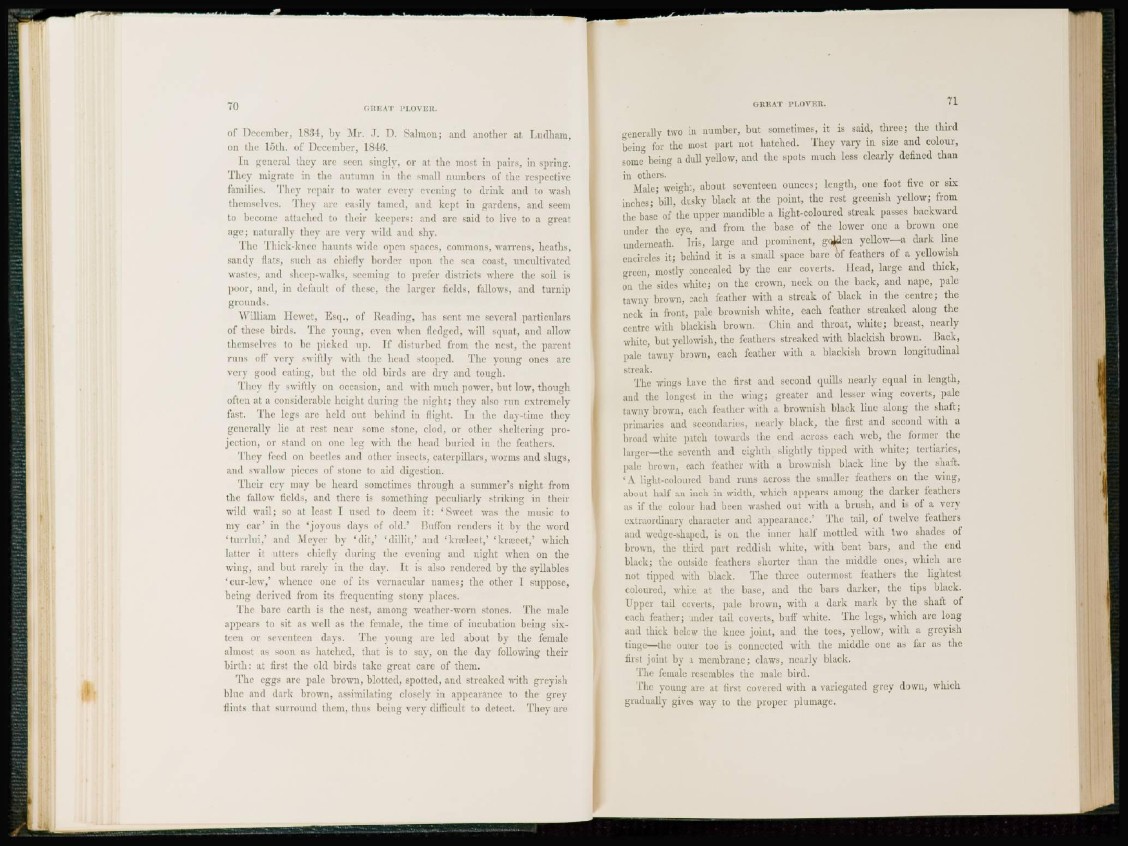
TÍ) GREAT PLOVER.
of December, 18.34, by Mr. J, D. Salmon; and another at Ludham,
on the loth, of December, 1846.
I n general they arc seen singly, or at the most in pairs, in spring.
They migrate in the autumn in the small numbers of the respective
families. They repair to water every evening to drink and to wash
themselves. They are easily tamed, and kept in gardens, and seem
to become attached to their keepers: and are said to live to a great
age: naturally they are very wild and shy.
The Thick-knee haunts wide open spaces, commons, warrens, heaths,
sandy Hats, such as chiefly border upon the sea coast, uncultivated
wastes, and sheep-walks, seeming to prefer districts where the soil is
poor, and, in default of these, the larger fields, fallows, and turnip
grounds.
William ffewet, Esq., of Reading, has sent me several particulars
of these birds. The young, even when fledged, will squat, and allow
themselves to be picked up. If disturbed from the nest, the parent
runs off very swiftly with the head stooped. The young ones are
very good eating, but the old birds arc dry and tough.
They fly swiftly on occasion, and with much power, but low, though
often at a considerable height during the night; they also run cxtrcmcly
fast. The leg- are held out behind in flight. T11 the day-time they
generally lie at rest near some stone, clod, or other sheltering projection,
or stand on one leg with (he head buried in the feathers.
They feed on beetles and other insects, caterpillars, worms and slugs,
and swallow pieces of stone to aid digestion.
Their cry may be heard sometimes through a summer's night from
the fallow fields, and there is something peculiarly striking in their
wild wail; so at least I used to deem it: 'Sweet was the music to
m\ ear' in the "joyous days of old." BufFon renders it by the word
E t u r r l u i , ' and Meyer In 'dit,' 'dillit,3 and 'kreeleet,' 'krEeeet,' which
latter it utters chiefly during the evening and night when on the
wing, and but rarely in the day. It is also rendered by the syllables
' c u r - l e w , ' whence one of its vernacular names; the other I suppose,
being derived from its frequenting stony places.
Tin bare earth i< the nest, among weather-worn stones. The male
appears to sit as well as the teníale, the time of incubation being sixteen
or seventeen days. The young are led about by the female
almost as soon as hatched, that is to say, on the day following their
b i r t h : at first the old birds take great care of them.
The eggs arc pale brown, blotted, spotted, and streaked with greyish
blue and dark brown, assimilating closely in appearance to the grey
flints that surround them, thus being very difficult to detect. They are
GREAT PLOVER. 71
generally two in number, but sometimes, it is said, three; the third
being for the most part not hatched. They vary in size and colour,
some being a dull yellow, and the spots much less clearly defined than
in others.
Male; weight, about seventeen ounces; length, one foot five or six
inches; bill, dusky black at the point, the rest greenish yellow; from
the base of the upper mandible a light-coloured streak passes backward
under the eye, and from the base of the lower one a brown one
underneath. Iris, large and prominent, golden yellow—a dark line
encircles it; behind it is a small space bare of feathers of a yellowish
green, mostly concealed by the car coverts. Head, large and thick,
on the sides white; on the crown, neck oa the back, and nape, pale
tawny brown, each feather with a streak of black in the centre; the
neck in front, pale brownish white, each feather streaked along the
centre with blackish brown. Chin and throat, white; breast, nearly
white, but yellowish, the feathers streaked with blackish brown. Back,
pale tawny brown, each feather with a blackish brown longitudinal
streak.
The wings have the first and second quills nearly equal in length,
and the longest in the wing; greater and lesser wing coverts, pale
tawny brown, each feather with a brownish black line along the shaft;
primaries and secondaries, nearly black, the first and second with a
broad white patch towards the end across each web, the former the
larger—the seventh and eighth slightly tipped with while; tertiaries,
pale brown, each feather with a brownish black line by the shaft.
' A light-coloured baud runs across the smaller feathers on the wing,
about half an inch in width, which appears among the darker feathers
as if the colour bad been washed out with a brush, and is of a very
extraordinary character and appearance.' The tail, of twelve feathers
and wedge-shaped, is on the inner half mottled with two shades of
brown, the third part reddish white, with bent bars, and the end
black; the outside feathers shorter than the middle ones, which are
not tipped with black. The three outermost feathers the lightest
coloured, white at the base, and the bars darker, the tips black.
Upper tail coverts, pale brown, with a dark mark by the shaft of
each feather; under tail coverts, buff white. The legs, which are long
and thick below the knee joint, and the toes, yellow, with a greyish
tinge—the outer toe is connected with the middle one as far as the
first joint by a membrane; claws, nearly black.
The female resembles the male bird.
i h e young are at first covered with a variegated grey down, which
gradually gives way to the proper plumage.